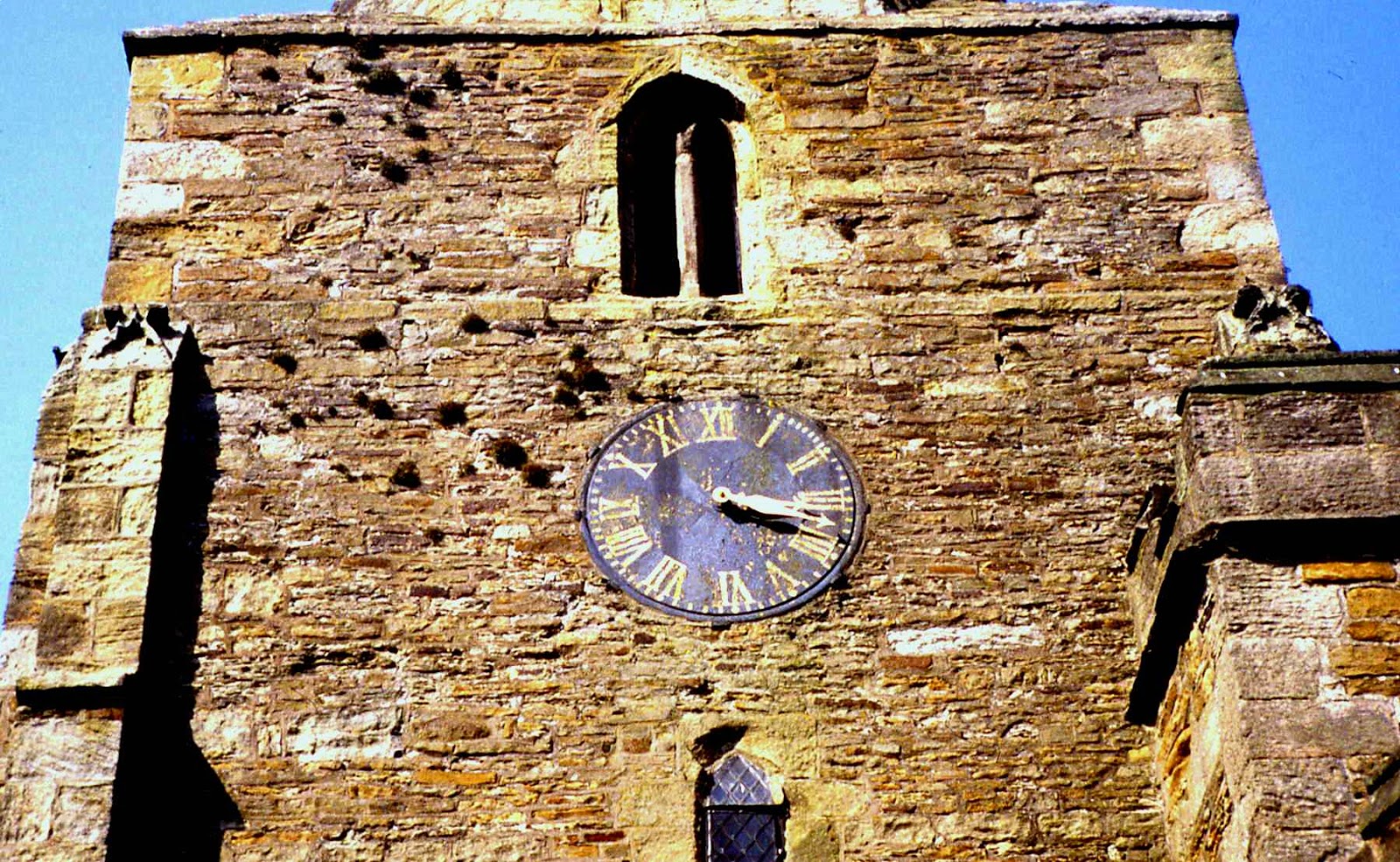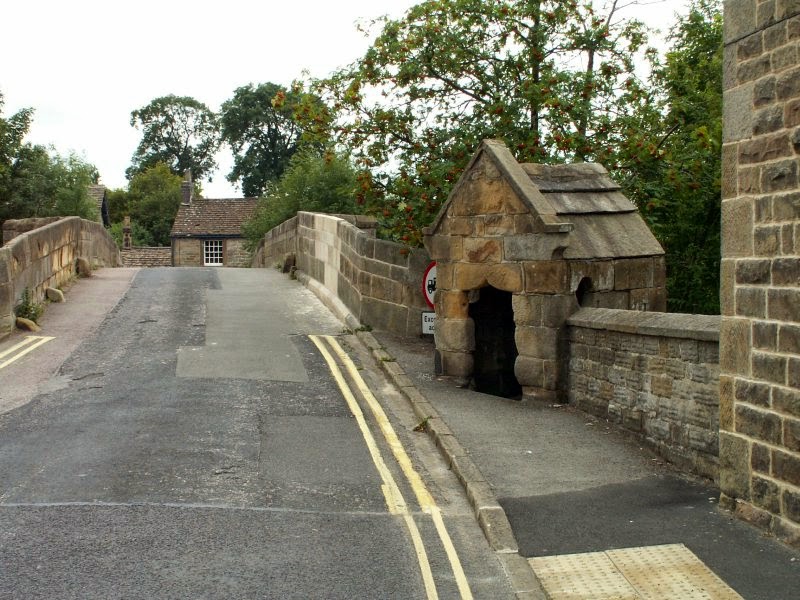The Peak District of Derbyshire became Britain's fist National Park in 1951.
One of the greatest church
curiosities in the land, the ‘twisted
spire’ of St Mary and All Saints church at CHESTERFIELD, dominates the
skyline. This church was built between 1234
and 1360 and, rising to 228ft, the spire leans 9ft 5ins from its true
centre. Its eight sides are covered by a
herringbone pattern of lead slates which trick the eye into seeing sixteen
faces from the ground, and the result is a crooked
spire.
Legend has it that a powerful
magician persuaded a Bolsover blacksmith to shoe the devil, who took flight
over Chesterfield where he lashed out, caught the church spire and twisted it
out of shape.The truth probably lies in the fact that unseasoned timbers became distorted over the years due to the heavy lead covering.
ARKWRIGHT TOWN, south east of Chesterfield, was for
many years a coal mining village with its close knit community of terraced
houses, until mining privatisation in the 1990’s when the local pit closed down. To add insult to injury it was subsequently
found that methane gas was seeping from the old workings into the houses and
the village had to be abandoned. The
village was rescued by a company who wished to opencast mine the area and in
1995 all 200 families were given new homes in a new purpose built village close
by.
Time goes by at a leisurely pace
in OLD BRAMPTON near Chesterfield
Pretty villages abound in the Peak District
and BASLOW, situated on the River Derwent close to Chatsworth, is no
exception. An ancient stone bridge
crosses the river in this small village and there is a curious little stone
toll booth built into one end.
The old village of EYAM is known as The Plague Village. When the village was struck by the plague in 1665, the 350 villager's put themselves in quarantine to stop it from spreading and 257 of them died.
An old Bull Ring is preserved in The Square.
The old village pub, The Miners Arms, at Eyam dates back to the early 17th century. We are reminded of an unusual incident which
took place in the pub in 1684 when the village rector, The Rev. Joseph Hunt
took part in a mock marriage between himself and the landlord’s 18 years old
daughter Ann. This bibulous frivolity
proved to have dire consequences for the rector, because when the bishop heard
about it he made the Rev. marry the girl properly, despite the fact that he was
engaged to another woman. We are not
told whether the marriage survived.
This fine gravestone can be seen in the churchyard at Eyam.
The pretty little town of BAKEWELL is a favourite tourist destination being close to Chatsworth House, and is famous for its 'pudding'.
The recipe for this desert was discovered by
accident as the result of a misunderstanding between the cook and the mistress
at the Rutland Arms Hotel in Bakewell around 1860
Instead of stirring the egg mixture into the pastry and then filling the
tart she was making with jam, the cook put the jam into the tart and then poured
the egg mixture over it. The resulting
desert was so successful that it became renowned as Bakewell Pudding.
Chatsworth House, the home of the Duke and Duchess of Devonshire is close to Bakewell. Unfortunately I don't have any photographs of the house at the moment.
Early in the 19th century, the 6th Duke of Devonshire made various alterations Chatsworth House. At that time he decided that the village of EDENSOR, close to his fine house, was any eyesore and razed it to the ground. He then had the village rebuilt away from the house, leaving his fine estate uncluttered by houses.
His new ‘model village’ was built just one mile away and no two buildings are the same. At the entrance to the village is a lodge which looks like a small castle, whilst in a corner stands a mock Swiss chalet in brown stone. Other houses have Tudor chimneys, Italian style windows, with a jumble of gables , porches and odd windows.
In 1601 a duck flew into a tree outside the Devonshire
Arms in the tiny village
of SHELDON just west of Bakewell
ALFRETON is a small former colliery town close to the M1 motorway which dates back to Saxon times. The old single storey lock-up in King Street dates to 1820 and bears the name, 'House of Confinement'.
In about 1600, Anthonie Bradshaw erected his own memorial in his parish
church at DUFFIELD near Derby. Although he described it as a ‘little
monument’ it was in fact 12 feet tall and commemorated his living self, his two
wives and his (then) 20 children. Born of an old Derbyshire family, Bradshaw
became a successful London
His monument is of sandstone, with obelisks and rusticated pillars, and
is inset with alabaster panels. They are full of inscribed information, some in
Latin and some in English, about
Bradshaw and his family. He and his family are portrayed in half-figure incisions identified by
initials with full names above and at the foot of the monument is an acrostic
of his name. The whole thing is topped with his coat of arms and crest. One thing missing is the date of his death
in 1614.
Bradshaw had a further three children before he died.
The monument was restored in 2002.
Francis Brown was an 18th
century yeoman farmer whose farm was near to the village of MUGGINGTON Derby
'Francis Brown in his old age
did build him here an hermitage 1723.
Who being old and full of evil
Once on a time haltered the devil'.
The chapel, known locally as Halter Devil Chapel, is still there and
can be visited. It is still used from
time to time for Church of England services.
The entrance to a private garden at MUGGINGTON is
through a huge privet hedge which has been cut into the shape of a cottage, complete with chimneys, and a wooden door completes
the entrance.
The curiously named village of WHATSTANDWELL is situated on the River Derwent near Belper, and on the Derwent Valley Railway.
A house built over the entrance to a railway tunnel
can be seen just outside the station. It is a fairly modern house and one wonders why it would be built on such and
unusual plot.
In the 1700’s a family
called Kenny or Kenyon lived in Shining Cliff Woods overlooking the Derwent Valley where Luke Kenny worked as a charcoal burner. It is said that Luke
and his wife Betty actually lived in a huge yew tree reputed to be 2000 years
old where they formed a house within the tree with a turf roof. Here they
brought up eight children. A bough of the tree was hollowed out as a cradle and
legend has it that this gave rise to the nursery rhyme ‘Rock a bye baby.’ Part
of the yew tree still remains and is known as
the Betty Kenny tree.
There is a complex of
old mills around the bridge over the River Derwent at BELPER.
Around 1800, a covered passageway was built over the Ashbourne Road
two on the other side.
There are two conical lock-ups in the south west close to the Leicestershire border and similar in design to three more over the border.
The one at SMISBY dates to the early 19th century and is Grade 11 listed.
The one at TICKNALL also dates to the same period and is Grade 11 listed.
It is said that in the 19th century, Eliza Soar was the landlady of the Staff of Life pub in the village and apparently her door key also fitted that of the lock-up. When the village constable had gone to bed, Eliza could be persuaded to release any incumbent of the lock-up.

















.jpg)


























No comments:
Post a Comment